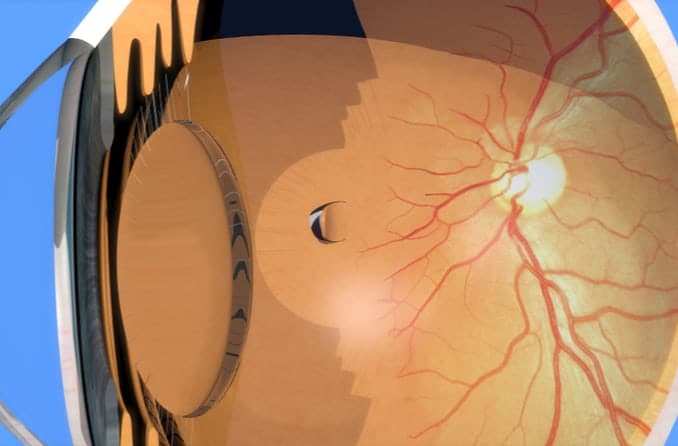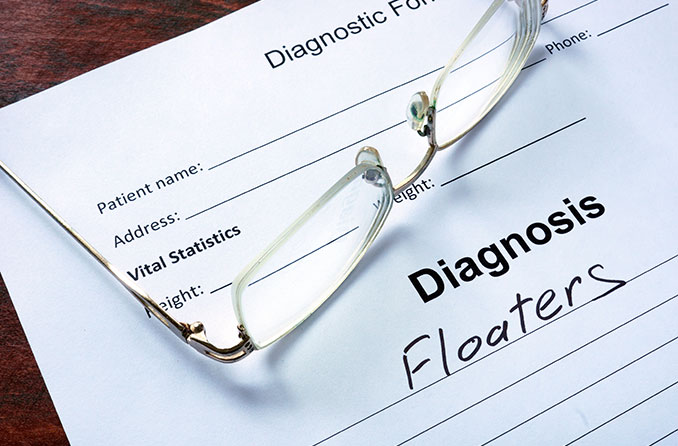What are eye floaters?
Eye floaters are small spots or lines that drift across your field of view. They can appear dark, shadowy or nearly transparent. They may resemble shapes such as circles, cobwebs or squiggly lines. Most floaters are harmless, but some signal a more serious condition that needs immediate attention.
If you notice an increase in or the sudden appearance of floaters, see your eye doctor promptly to determine the cause.
What causes eye floaters?
Floaters can appear for a variety of reasons, ranging from normal, age-related changes to more serious eye conditions:
Age-related changes in the eye (most common)
Floaters are most often caused by age-related changes that occur inside the eye. Over time, the vitreous humor (a clear, gel-like substance that fills the center of the eye) begins to liquify and shrink. This is followed by vitreous syneresis (clumping) and liquefaction (causing clear pockets), which can cause floaters to appear.
If the vitreous then pulls away from the back of the eye, it is referred to as posterior vitreous detachment (PVD). As the vitreous separates, tiny collagen fibers within it can clump together. The clumps project shadows onto the retina (the light-sensitive membrane at the back of the eye). This causes these shapes to appear as floaters in your vision.
PVD typically occurs in patients aged 50 and older but can occasionally affect younger people as well.
Eye conditions and injuries
Several eye conditions and types of eye trauma can also cause floaters. While these causes are less common, they often indicate a more serious underlying concern.
Floaters may be a symptom of the following eye conditions:
- Retinal tears – These develop when the vitreous shrinks and pulls on the retina, causing it to tear.
- Retinal detachment – This occurs when the retina separates from the back part of the eye.
- Eye inflammation – A type of posterior uveitis (inflammation of the eye’s middle layer) can cause floaters. This form of uveitis can result from autoimmune diseases (such as sarcoidosis and multiple sclerosis) and infection (by organisms such as toxoplasma, toxocara and many others).
- Vitreous hemorrhage (bleeding in the vitreous) – This can result from trauma or conditions like retinal tears, PVD or diabetic retinopathy (where retinal blood vessels leak into the vitreous).
- Asteroid hyalosis – This condition often leads to the appearance of sparkling floaters. While they are usually not a problem for the patient, they can make it much harder for the doctor to diagnose a problem as the sparkling of the floaters interferes with the eye exam.
- Ocular migraine – An ocular or retinal migraine can lead to visual effects such as floating lines, blurry spots, sparkling lights and visual aura.
- Visual snow syndrome – This rare condition can cause a person’s vision to appear “snowy” in addition to causing floaters and photophobia (light sensitivity).
- Eye injuries – Trauma to the eye can cause PVD, retinal detachment and other complications that cause floaters.
You may also be at a higher risk of developing floaters if you have or have had:
- Myopia (nearsightedness)
- Recent eye surgery
- Diabetes
- Family members with retinal tears or detachment
READ MORE: Eye floater causes
How do eye doctors check for floaters?
Eye floaters are typically diagnosed during a comprehensive eye exam. Your eye doctor will dilate (widen) your pupils with special eye drops. This gives them a clearer view of structures in the eye, such as the vitreous and retina. A special microscope called a slit lamp is often used to examine these and other parts of the eye closely.
If floaters are found, your eye doctor may perform other tests for a more detailed retinal exam. This may include:
- Indirect ophthalmoscopy – A head-mounted light and special lens are used to view the entire retina.
- Imaging tests – Optical coherence tomography (OCT) and ultrasound may also help identify the cause of floaters and further evaluate the condition.
What are the treatment options for floaters?
Treatment for eye floaters usually isn’t necessary. In most cases, they’re a normal part of the natural aging process and aren’t a concern unless they impact your eyesight. Your eye doctor may simply monitor them over time.
When floaters are caused by other eye conditions, addressing the underlying problem can help reduce or eliminate them.
If floaters significantly interfere with your vision or become particularly bothersome, the following procedures may be considered:
Vitrectomy
A vitrectomy is a surgical procedure that removes the vitreous humor from the eye. The surgeon usually replaces the vitreous with an injection of saline solution. This procedure is typically reserved for severe or disabling floaters. While it can be helpful, the procedure carries several risks, including the development of retinal tears and detachment, cataracts, and infection.
Laser treatment
During a procedure called vitreolysis, a specialized laser is used to break up or vaporize floaters in the vitreous humor. This can make floaters less noticeable, but results vary from person to person. It also carries certain risks, including cataract formation, retinal damage and increased eye pressure, which could lead to secondary glaucoma.
SEE RELATED: Can you reduce eye floaters naturally?
When should you see an eye doctor?
While annual eye exams are necessary for overall eye health, it’s essential to see an eye doctor if you notice changes in your vision, including floaters. Not all floaters are cause for concern, but certain changes warrant prompt evaluation.
Contact your eye doctor immediately if you experience:
- A sudden appearance of floaters
- A sudden increase in floaters
- Floaters in combination with other symptoms, such as flashes of light
- The appearance of a shadow or curtain over your vision
These symptoms can point to a more serious problem that requires immediate care, such as a retinal tear or detachment.
Even if floaters seem to have a more gradual onset or aren’t interfering with your vision, it’s still important to schedule an eye exam. Monitoring them helps detect any underlying conditions as early as possible.
Frequently asked questions about eye floaters
Because floaters are so common, people often have questions about them. Some of the most frequently asked questions and their answers include:
Can younger people get eye floaters?
Yes, eye floaters can occur in younger people. While floaters most often affect those aged 50 and older, younger people may still experience them, including those who are nearsighted or have other risk factors.
Can eye floaters go away on their own?
Floaters won’t technically “go away” once they form and don’t disappear completely. However, they can become less noticeable over time.
Can stress cause floaters?
There’s no evidence that stress causes eye floaters. However, it triggers the release of hormones like adrenaline and cortisol in the body, which can make the pupils larger. This lets more light into the eyes, which makes floaters more visible.
These hormones can also heighten your alertness. As a result, you may become more aware of floaters that were already present in your vision.
Can floaters lead to blindness?
Floaters do not usually lead to blindness. But they can sometimes signal serious conditions that may cause permanent vision loss without prompt care.
Can vitamins or home remedies help reduce floaters?
Some studies suggest that certain antioxidants and nutrients may reduce symptoms associated with eye floaters. However, more research is likely needed to further support these findings.
Certain nutrients and lifestyle habits may support overall eye health and help lower the risk of conditions that can lead to floaters. Ask your eye doctor about the best ways to protect your vision and monitor for any changes.











